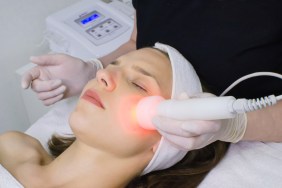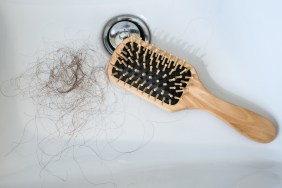It’s something that many women will have to face at some point in their lives — hair thinning or hair loss. According to the American Academy of Dermatology, about 40 percent of the female population will experience visible hair loss by the time they are 40. And as personal and provocative as hair can be, for many it’s the link to their feminine identity. So, nothing is more devastating than when a woman’s crowning glory starts to noticeably shed.
On average, women have between 100,000 to 150,000 strands of hair on their heads. And according to Anabel Kingsley, a Philip Kingsley trichologist, at any given time, approximately 90 percent of your hair will be in the growth cycle, while 10 percent will be shedding. The hair grows in a cycle of three distinct phases:
- The anagen stage is the active growth phase, which controls how long your hair is able to grow. It can last anywhere from three to seven years on average and is genetically determined.
- The catagen stage is an intermediary phase where the old hair begins to detach from the living part of the hair.
- The final stage, the telogen phase, is considered the resting cycle in which old hair sheds and the hair papilla rests. This lasts for about three months before it becomes active again, resulting in new hair growth.
“Excessive daily hair loss in women occurs when an internal imbalance or upset causes hairs to move prematurely from the anagen growth phase to the shedding phase,” states Kingsley. “This can result in as many as 300 hairs being lost a day.” (The average normal amount is 80 to 100 hairs daily.) The most common triggers are anemia, iron deficiency, lack of dietary protein, rapid weight loss, thyroid disorders and hormonal imbalances.
Types of Hair Loss in Women
Hair loss in women can be caused by a wide variety of different factors. The two most common types of hair loss are hair thinning and telogen effluvium.
Telogen Effluvium (Excessive, Diffuse Daily Hair Shedding)
Hair cells are the second fastest growing cells the body produces; yet, since hair is also nonessential tissue, it is extremely sensitive to any internal disruptions. When such a disruption occurs, many more hairs than usual can move from the anagen phase of the hair growth cycle into the shedding phase. This results in telogen effluvium, a type of hair loss that presents itself as excessive daily hair shedding from all over the scalp. Telogen effluvium occurs when the hair growth cycle is disrupted by an imbalance or upset in the body. The most common triggers are thyroid disorders, certain medications, stress, pregnancy, polycystic ovary syndrome, dietary deficiencies and low iron. Not every woman will experience hair loss as the result of these imbalances; some people are more prone to telogen effluvium than others.
Due to the nature of the hair growth cycle, telogen effluvium occurs around 6 to 12 weeks after the event that caused it. Luckily, it is only temporary and hair should grow back once the underlying causes are resolved.
Genetic Thinning
Genetic thinning occurs when hair follicles are genetically predisposed to being sensitive to normal levels of circulating male hormones called androgens. This causes hairs in pre-determined areas to gradually grow back finer and shorter. While it may be accompanied by excessive daily hair loss, this is not always the case.
Traction Alopecia
This type of hair loss occurs when constant traction is exerted on hair within its follicle. “Most commonly this is from tight braids or too-tight ponytails. Initially, traction can simply cause breakage and temporary loss, but over time the follicle can atrophy and the loss may become permanent,” says Kingsley.
Cicatricial (Scarring) Alopecia
This is a permanent hair loss, where the follicles become scarred and unable to produce hair. “It can either be caused by damage to the skin (e.g., severe chemical burns from peroxide),” adds Kingsley, “or be due to a faulty immune response.”
Alopecia Areata
Alopecia areata is a type of hair loss that occurs in patches. “We are not 100 percent certain of the cause, but it is thought to be autoimmune,” says Kingsley. “Studies show it occurs when the body recognizes hair cells as foreign and attacks them as it would an invading pathogen.”
Postpartum Hair Loss
Approximately 50 percent of women suffer from hair loss about 6 to 10 weeks after giving birth, or after stopping breastfeeding. “During pregnancy, high estrogen levels keep the hair in the growing phase for longer and so less hair is shed than usual. When estrogen levels return to normal, all the extra hair retained during pregnancy can shed at once,” explains Kingsley. Luckily, this type of hair loss is temporary; it will stop on its own accord with all hairs lost growing back.








